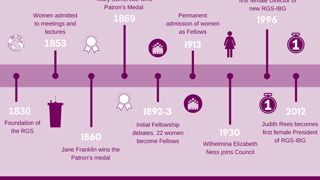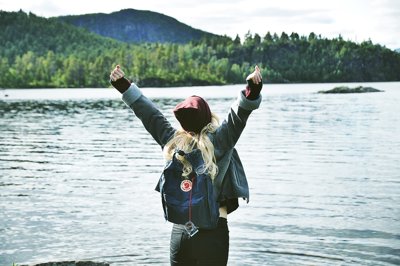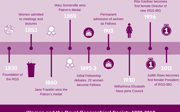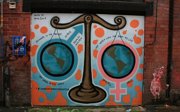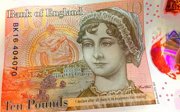On 8 March International Women’s Day is celebrated around the world. Each year a theme is chosen, and in 2018 that theme is #PushForProgress which reflects the strong global movements currently striving for gender parity. This day represents an important occasion to mark the importance of gender equality to sustainable global development, but as this article will discuss raising awareness and making visible gender inequalities should be part of our everyday actions and environments. According to the World Economic Forum (2017), when it comes to health and economic progress, it is projected that the gender gap will take 217 years of progress before it is closed. Political progress is even wider, it is projected to have closed within 99 years. In short, governance and action is needed that supports women and girl’s access to public and private spheres in society.
In this article and accompanying podcast we reflect on the history of geography and women geographers who have campaigned for gender equality. We will introduce how gender impacts and shapes our experience of space and place.
Key questions
-
How does gender inequality appear around the world?
-
What is feminist geography?
-
Why is gender important to understanding space and place?
-
What is the history of women at the Royal Geographical Society?
Introduction
Given that women occupy so many spaces and places of social, political and economic importance, it is easy to assume that equality is universal. But that is not the case, especially beyond the Global North. Globally, it is understood that of the 800 million people that continue to live in poverty they are more likely to be women than men. This is addressed by Sustainable Development Goal number five which aims to achieve gender equality and empower all women and girls by 2030. Women’s access to political life continues to be globally unequal, and historically protest and activism have played an important part in the bid for gender equality.
In 2018, on 6 February it marked 100 years since the Representation of the People Act was passed in 1918 – this meant that some women in the UK received the right to vote. Similarly, in 2013, female geographers celebrated 100 years since the inclusion of women to the fellowship of the Royal Geographical Society. This meant that women were formally recognised as official full members of the Society. In our podcast recorded to mark International Women’s Day 2018 you can hear from Dr Sarah L. Evans whose PhD research explored the role of Women at the RGS between 1913 and 1970. The timeline below also shows a selection of ‘firsts’ that have occurred at the Society, including medals and awards winners.
How have women shaped geography?
Geographers are interested in space, place and how they are experience – this experience shapes identity, and indeed our identities and experience shape how we experience a place too. This idea is advocated and advanced by feminist geographers who put gender at the fore of their geographical research. Feminist geographers are also interested in social justice and equality for all genders; recognising the role that both women and men play in society as well as how that intersects with identity categories such as age, class, race and sexuality.
In terms of landscape, feminist geographers have noted that the urban landscape especially is coded as a masculine space – this means that the buildings, statutes, and architecture of cities, for example, reflect patriarchal societal norms built on men’s access to space. Therefore, if women are to be empowered and to experience equal rights their visibility in public spaces and landscape is critical.
The history of women and women’s stories are often less visible than male counterparts. For example, men are more likely to be celebrated with statues, portraits and busts in public spaces. Infact, according to research in 2016 only 2.7% of the UK’s statues were historical, non-royal women. This has led to campaigns which aim to make women more materially visible and celebrated in public spaces. For example, in the UK the £10 note was recently redesigned to include well-known author Jane Austen, and in April 2018 a statute of suffragist Millicent Fawcett will be unveiled in Parliament Square, London.
Women at the Royal Geographical Society
In 2013, the Gender and Feminist Geographies Research Group who encourage the study of gender and difference in geographical research marked the centenary of women’s admission to fellowship at the Royal Geographical Society. The GFGRG used the term ‘100+’ to recognise that before this official admission, women had been travelling, research, writing and teaching for many years. As part of their celebrations, a portrait of eight ‘female firsts’ were put together to hang on the walls of the Royal Geographical Society – a space that is largely decorated with images, statues, and figures of ‘heroic’ explorers. These portraits included the following women:
-
Lady Jane Franklin: organiser and supporter of a series of key expeditions, and the first woman awarded a Gold Medal by the Society in recognition of this important work.
-
Isabella Bird Bishop: one of the first women to be elected as a Fellow of the RGS in 1892.
-
Eva Taylor: first UK female professor of geography.
-
Alice Garnett: first female president of the IBG and the Geographical Association
-
Judith Rees: first female President of the RGS
-
Linda McDowell: first female editor of the academic journal Area
-
Alison Blunt: first female editor of the academic journal Transactions of the Institute of British Geographers
-
Rita Gardner: first female Director of the RGS-IBG and first female editor of the Geographical Journal
Conclusion
Only 13% of countries dedicate budget to studying gender data and statistics. When it comes to writing women’s stories, histories and geographies the lack of data or representation is marked. As discussed in this article, public spaces and aesthetics often lack gender equality in their very design, but more broadly stories of women and girls are less likely to be documented and told. The UN’s flagship programme is called ‘Making Every Woman and Girl Count’ advocates an increase in the amount and availability of data that portrays the lived reality and experience of women around the world. As geographers, it is vital to put gender at the fore of our investigations into space and place – locally, nationally, and internationally – and to celebrate the diverse achievements of women (economically, socially, culturally and politically), in ways that make those achievements visible and shape spaces that can further empower women too.
Key words
Gender
The social and cultural differences experienced between the two sexes of men and women.
Gender parity
A numerical concept, that seeks equal proportions between men and women.
Feminism
The advocacy of women's rights on the grounds of gender equality.
Lived experience
Personal knowledge of the world that is gained through direct experience in everyday life and events.
Intersectionality
Recognising the way that race and gender intersect, and provide diverse identities and therefore particular life experiences.
Feminist geography
An approach in human geography which uses feminism and gender to study the environment, society, space and place.
Lesson activities
As a class, ask students: what makes a good geographer? Ask your students to give their answers. This activity is to elucidate any stereotypes they may have, and how they construct the identity of ‘geographer’.
Students can listen to the podcast by Dr Sarah L. Evans on the history of the Royal Geographical Society. Ask them to make notes on the following:
-
When were women granted Fellowship to the Society?
-
Women were doing geographical work before this, how did they work within those constraints?
-
Why were social networks important for these geographers to access space?
-
Why are women’s histories and experiences sometimes not reflected in historical accounts?
Students should take a look at the UN Women’s Timeline to update their knowledge of women’s access to political life. What are some of the key dates? They can produce their own short timeline.
Download the document Women and the RGS Timeline. In pairs, students should research one of the women mentioned on the timeline, and as a class annotate together to produce a fuller history to display in class.
Students can visit the website Invisible Women. Are there statistics about statutes in their local area available? If so, what do they reveal? If not, can students research this information for themselves? Ask them – who, from their local area – would they erect a statue of and why? They should consider the ways this woman has contributed to the local area.
Ask students to think about a geographical role model – an academic, explorer, teacher, or public figure – research their lives and find ten interesting facts about them. Turn these facts into a quiz. This quiz can be shared with your peers.
At the end of class, ask students again – what makes a good geographer? This should elucidate any stereotypes, or tropes around heroes etc. and encourage students to identify different values and support that geographers, in their ultimate exploration for inequality, should display.
Links
Gender Feminist Geographies Research Group
International Day of the Girl (Freedom Video)
Global Goals
World Economic Forum Global Gender Gap Report (2017)
Evans, S., Keighren, I., Maddrell, A. (2013) Coming of age? Reflections on the centenary of women's admission to the Royal Geographical Society. Area. 179 (4) 373-376
Evans, S. Mapping Terra Incognita: Women’s Participation in Royal Geographical Society-Supported Expeditions 1913-1939
The Urgency of Intersectionality, Kimberlé Crenshaw, Ted Talk (2016)
18 Women in the Workplace Statistics you need to know (in 2021)
